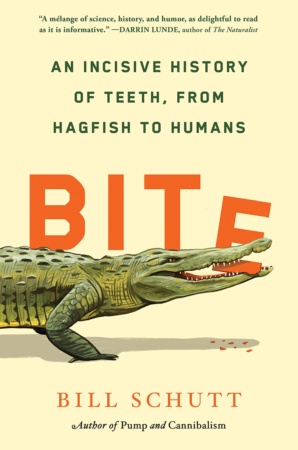Let’s see those pearly-whites.
C’mon, smile big for everybody. Show those straight dazzling teeth, You know you’re not completely dressed without it, so give us that grin. Let’s see some chompers ear-to-ear or, as in the new book “Bite” by Bill Schutt, in rows along the nose.
We humans share a lot of features with our vertebrate brethren. We have closed and protected spinal cords, and some vertebrates have bones or “a form of connective tissue” resembling bones. Most of all, “near the top of our list,” we have teeth in common.
The caution is that not all teeth are the same as the dazzling ones you see on TV ads.
For example, the teeth of vampire bats are not vampire-like at all; their teeth help the creatures cut into the hide of their prey, so they can lap up a meal of blood. The dental work of the candiru, a small Amazonian fish, all face backward, which helps keep the creature in tight, dark places such as between fingers and up urinary tracts. Ouch.
Horse teeth grow throughout the equine’s entire life, and you can tell a horse’s approximate age because it’s “long in the tooth.” An elephant’s tusks are teeth, but there’s an assembly line of molars waiting inside the creature’s mouth, too. A snake’s fangs are conveyors of venom, but also work to hold prey in place. Parrotfish teeth allow the creature to scrape and eat at coral, which is then excreted as sand and which “benefits humans who want to lie on that poop or form it into miniature castles.”
Tiny shrews’ bites are venomous, but they’re unlikely to kill you. Conversely, alligators, crocodiles, and caimans can, though, with a force of more than seven hundred pounds. Sharks can have “upward of thirty thousand teeth over a lifetime…” On the other hand, chickens don’t have teeth, nor do whales.
As for us humans, says Schutt, our teeth tell a lot of tales – about our health, wealth, dietary habits and, in history, teeth tell who had “dismal dental” habits…
You’ve posed in your share of pictures this summer, at family reunions, weekend get-togethers, kids’ events, and you’ve smiled so much, your jaws hurt. So now why not learn what’s behind your lips in “Bite”?
In a trip around the vertebrate world, author Bill Schutt helps readers to stare into the mouths of danger, death, and the fascinating, all from the safety of their chairs. Sometimes, that can be gruesome; sometimes, it may seem unbelievable; but he makes it funny, too, with plenty of geek humor and researcher jokes. Readers who’ve never considered the mouths of unfamiliar beings will be surprised at what they learn, and delighted at the tiny drops of knowledge to be had here. You’ll cringe, you’ll be amazed, and you’ll feel like a real scientist because the information is easy to understand.
This book will work for an older teen, a gift for your dentist, or for readers who like unusual science books. Find “Bite” and say “cheeeeese.”
“Bite: An Incisive History of Teeth, from Hagfish to Humans” by Bill Schutt
c.2024, Algonquin Books
$31.00
320 pages




